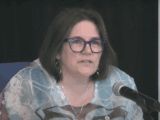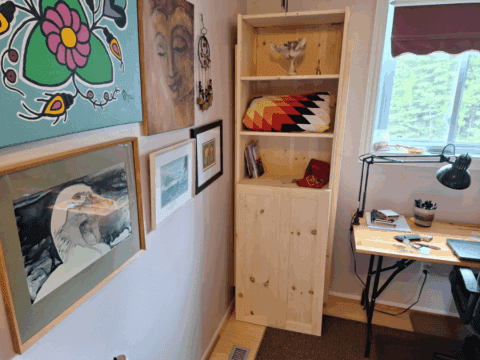Sept. 14 was a sunny Saturday in Place du Canada, Montreal. But instead of the usual dog walkers and amorous couples, the downtown park was filled with thousands of people, young and old, congregating to protest proposed changes to Quebec law.
The Charter of Quebec Values, with its provision that would prohibit public employees from wearing conspicuous religious symbols at work, was renamed and tabled as a bill in the provincial legislature in early November. All autumn, it stirred passions and dominated headlines in the province. And with weighty ideals in question such as the separation of church and state, multiculturalism and freedom of religion, the rest of Canada has been paying attention, too.
But for the police helicopter hovering overhead, the protest looked much like an interfaith family picnic. Grandparents handed sandwiches to peckish kids; a circle of teenage girls conversed shyly; mothers peeked into strollers to smile at each other’s babies. Many of the participants were wearing hijabs (head scarves), turbans or skullcaps, all of which would hinder their employment options should the values charter become law. One man paraded by with a large crucifix. Some folks had no visible religious affiliation but brandished signs with humanist messages such as “My values include tolerance.”
Meanwhile, away from the public eye, Amber Rehman was doing some soul-searching. A hijab-wearing anti-bullying activist and professional blogger, she struggled to find the heart to break the news of the proposed religious-symbols ban to her 12-year-old daughter.
“She’s at the age where you start thinking about your future options and studies,” she says. “And now I had to tell her that if she takes an interest in religion and makes certain choices, then she might no longer be welcome in a lot of potential careers.”
The Charter of Quebec Values would indeed affect a large swathe of occupations, including doctors, nurses, daycare workers, police officers, judges, prosecutors, firefighters, corrections officers, professors, teachers and social workers.
A Quebec native who travels widely, Rehman finds it strange that she feels accepted with her leopard-print hijab elsewhere in the country, but judged and stigmatized in her own hometown — “the place where you want to feel the most comfortable.”
“And this is a time when the Internet is shrinking the world and people are coming together, figuring out their common values and accepting their differences,” she says. “It’s really weird to see my government, in 2013, trying to devalue these differences.”
Quebec’s government is currently controlled by the Parti Québécois (PQ), which sees the charter as a peacemaking proposition.
“A number of high-profile religious accommodation cases have given rise to a profound discomfort in Quebec,” reads a government website explaining the charter. “To maintain social peace and promote harmony, we must prevent tensions from growing. Clear rules on religious accommodations will contribute to integration and social cohesion. They will benefit all Quebecers, including newcomers.”
The religious accommodation cases referred to include one in which a Sikh boy was forbidden to wear a kirpan (ceremonial dagger) under his clothing at school. This decision was upheld by the Quebec Court of Appeal but then, in a move seen by some Quebecers as federal interference, overthrown by the Supreme Court of Canada.
“[Public] reaction was swift, much of it negative, and much of it focused on the idea that there was simply ‘too much’ accommodation happening,” writes University of Ottawa professor Lori G. Beaman in the academic anthology Reasonable Accommodation: Managing Religious Diversity.
Since then — and in contrast to the rest of Canada — Quebec has attempted to address religious accommodation away from the courts. But like an open sore, the issue seems to flare up whenever the government rubs it.
The Bouchard-Taylor commission, a series of public hearings on how far accommodations should go, was plagued by embarrassingly racist comments from some participants. And the government recently had to distance itself from a pro-charter of values demonstration at which the chant “Retournez chez vous!” (“Go back home!”) was heard.
Critics charge that the PQ’s intention was never to promote social harmony — rather, the charter is “a cynical ploy by a weak sovereigntist government to create an issue that may help divide Quebec from Canada,” as constitutional lawyer Deborah Coyne put it.
But even if the party’s stated intentions are sincere, its methods have backfired: ever since the charter of values was introduced on Sept. 10, verbal and physical violence directed at hijab-wearing women has increased, according to L’R, a provincial coalition of women’s centres.
In the French-language newspapers, much of the discussion about the charter of values has to do with protecting Quebec’s distinct culture. But for those without a stake in Quebec identity politics, the most compelling argument for banning religious symbols in government-run institutions is that it would further the separation of church and state.
As the charter’s website explains, Quebec society has been evolving in this direction ever since the Quiet Revolution of the 1960s weakened the pervasive influence of Roman Catholicism in public life.
With religious sources no longer informing government policies, the province soon recognized civil marriage. Then came the decriminalization of contraception, abortion and homosexuality, and the adoption of a secular education system. From a certain point of view, ridding provincial institutions of religious symbols is the next logical step.
But is separating religion from the public sphere a worthy project in the first place? Not long after the values charter was announced, a modest group of supporters met in an old stone building on the premises of the Université de Montréal to hear from a panel of experts.
“You’re not going to paint us as fascists, are you?” asked the receptionist when he saw my recording device and confirmed that I was attending the event as a journalist.
“Er, no,” I said, unable to discern whether he was joking. “I’m here to listen to Djemila Benhabib.”
An outspoken proponent of secularism, Benhabib is the author of a well-received memoir about her younger days in Algeria, where the political rise of the Islamic Salvation Front threatened to undermine the status of women — until the country plunged into a civil war.
“Islamism poses a problem first of all to Muslims themselves,” she told a scrum of news reporters, making an implicit distinction between Islam (a religion) and Islamism (the view that this religion should control politics and inform state policies). “Even in the Muslim world, there’s a conflict between Islamists and feminists and democrats. We have to figure out how to adapt this religion to modernity, because that’s how it should be — the state shouldn’t be the one adapting.”
Evoking a few outrageous acts committed by certain Islamic governments, such as the whipping of so-called adulteresses, she continued: “It frightens me to see the widespread incomprehension of secularism. It’s a separation of spaces. I’m proud to live in a country that pushes for it.”
The founders of America, having witnessed the hardship wrought by religious politics in Europe, made their own arguments in favour of keeping religion and government separate. With unchecked and unbalanced power, wrote John Adams in an 1813 letter, “the Deists would persecute Christians, and Atheists would persecute Deists, with as unrelenting Cruelty, as any [denomination of] Christians would persecute them or one another. Know thyself, Human Nature!”
By contrast, Canada has not enshrined the separation of church and state in its founding documents. Our constitution references “the supremacy of God,” and our head of state, the Queen, is also head of the Church of England. Nevertheless, the idea that religion belongs in the private sphere enjoys popular support. As one man at the secularism colloquium said, “With this charter, we’ll be doing a favour to the rest of Canada, too.”
So far, though, the rest of Canada has followed a different path. In a report to the 18th International Congress of Comparative Law in 2010, social scientists Rosalie Jukier and José Woehrling sum up this approach: the secular state is not seen as an end unto itself but rather as a means to freedom of religion, which is guaranteed by the Canadian Charter of Rights and Freedoms.
“A ‘strict’ or ‘rigid’ conception of secularism would accord more importance to the principle of neutrality than to freedom of conscience and religion,” Jukier and Woehrling write, “leaving the public sphere free of any expression of religion. . . . This concept of secularism is obviously less compatible with religious accommodation.”
By contrast, “a more ‘flexible’ or ‘open’ secularism . . . is based on the protection of freedom of religion.” In this model, state institutions are secular but individuals are not required to erase religious markers in public. Open secularism recognizes “that secularism and pluralism are both realities of Canadian society.”
Palbinder Kaur Shergill knows all about this distinction. A prominent B.C. lawyer, she represented the World Sikh Organization in a case about a Mountie named Baltej Singh Dhillon, who wished to wear a turban with his uniform. The three retired RCMP officers who filed a lawsuit against Dhillon’s accommodation argued that “they have the right to freedom from religion and this right superseded Dhillon’s right to freedom of religion,” Shergill recently told the Sikh Feminist Research Institute.
The Federal Court of Canada disagreed. “One of the major purposes of the Charter [of Rights of Freedoms] is to protect, within reason, from compulsion or restraint,” the decision acknowledged. However, the judges weren’t convinced that simply being able to see the religious affiliation of a police officer would fall into this category of “compulsion,” i.e., being forced to participate in a religion. There is “no necessary religious content” to the interaction between a turbaned officer and a member of the public, they concluded.
Shergill admits that freedom of religion — like all freedoms — entails responsibilities.
“In law school, we learn that my right to wave my arm freely ends when it connects with your face,” she says. “Similarly, religious freedoms may need to be restricted where there is harm to someone else. But secularism in a democracy such as ours in its simplest terms means that the government does not promote any one religion. It does not mean that you must strip all religious references and identities.”
It is precisely this “stripping” that religious groups have denounced in their responses to the charter of values. It will “run contrary to the provisions enshrined by . . . the Canadian Charter of Rights and Freedoms,” the Centre for Israel and Jewish Affairs stated.
Quebec Muslims for Rights and Freedoms, a coalition of over 60 Muslim groups, echoed this sentiment, as did local United Church bodies — even though their members are unlikely to be directly affected.
“We hear the hurt of our neighbours and friends who are feeling publicly shunned,” read the Montreal and Ottawa Conference’s statement. “We need them to feel free to live their faith with integrity not only in the privacy of their homes, but on the streets and in their places of employment as equal citizens in our province and country.”
Sixteen female United Church ministers also signed an open letter from Quebec feminists criticizing the charter, and Moderator Rt. Rev. Gary Paterson added his name to a statement of concern from the Canadian Interfaith Conversation.
At the Immigration Canada offices in Montreal, it’s almost time for a citizenship ceremony — an embodiment of the Canadian ideal of multiculturalism. Each soon-to-be Canadian has been given a booklet titled Symbols of Canada. With nothing much to do while they wait for the ceremony to begin, three young Arabic-speaking women are leafing through it, digesting the collection of national and provincial flags, crests, flowers and animals.
I wonder what they might make of Canada’s motto, A Mari Usque Ad Mare, which, as the booklet artfully does not explain, is an excerpt from Psalm 72:8 — “And God’s dominion shall stretch from sea to sea.” The maxim speaks to a less multicultural time in Canada’s history when many church and government leaders believed in upholding Christianity from the Atlantic to the Pacific.
“If the Canadian civilization fails to assimilate the great mass of foreigners admitted to our country,” wrote C.J. Cameron of the Baptist Home Mission of Ontario and Quebec in 1913, Christian ideals would be “supplanted by a lower order of habits, customs and institutions. . . . We shall Canadianize the foreigner by Christianizing him.”
Initially, Canadian state secularism was a way to address the discrimination that resulted from this kind of attitude. It was a step forward for multiculturalism, for example, when the Lord’s Day Act was revoked in 1985, allowing merchants to conduct business on Sundays, in recognition that non-Christians celebrate the Sabbath on other days of the week or not at all.
But these days, secularism is “the solution that has become part of the problem,” according to University of Waterloo religious diversity expert David Seljak. His report Religion and Multiculturalism in Canada, co-authored with four other social scientists and presented to the Department of Canadian Heritage, contends that “an emerging ‘closed’ secularism has the potential to promote intolerance and discrimination,” which in turn could weaken “mutual respect, and ultimately erode social cohesion.”
Seljak and his colleagues go on to explain that “anti-immigrant hostility is frequently fueled by feeling that ‘they’ are not like ‘us.’ Earlier, it meant that ‘they’ were not Christian like ‘us.’ Now it often means that ‘they’ are not secular — that is, enlightened, liberal, rational, etc. — like ‘us.’” In other words, Seljak fears that we’re seeing the pre-multicultural, colonial attitude of yesteryear in a new guise.
A powerful statement to this effect came from the Quebec chapter of the Idle No More movement, which said of the charter of values, “Its approach simply follows in the history of neo-colonialist assimilation that remains fresh in the hearts of First Nations people. In the past, our ceremonies, sweat lodges, potlatches, dances, songs, religious and spiritual symbols . . . were forbidden through the same kind of colonial policies that now threaten other religious practices.”
The great majority of experts — from political philosophers to sociologists — agree that “open” secularism is the more logical way for Canada to go if it wants to respect freedom of religion and multiculturalism.
However, the general public seems to be on a different page. An August Forum Research survey found that the concept of controlling religious symbols in government-run workplaces has the support of just over half of Quebecers, 40 percent of Ontarians and slightly fewer of the residents of other provinces. For the more radical proposal of banning religious symbols in all public spaces, the support dropped to 32 percent — still a sizable minority.
Presumably, or at least hopefully, these Canadians are not all motivated by malice or prejudice but instead believe, along with the PQ, that “closed” or “robust” secularism is the path that will promote equality and ultimately bring the country together.
In Canada Place, where thousands marched against the Charter of Quebec Values in mid-September and where hundreds of charter supporters gathered a week later, there stands a memorial to former prime minister Sir Wilfrid Laurier. It’s inscribed with his words, “The governing motive of my life has been to harmonize the different elements that compose our country.” Paradoxically, both the charter’s opponents and its proponents claim to share Laurier’s goal.
***
This story first appeared in The United Church Observer’s December 2013 issue with the title “The gospel of secularism.”














